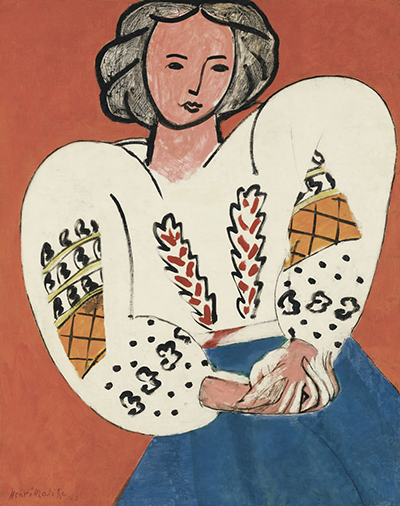This charming portrait features a beautifully dressed woman within an abstract style where Matisse uses a limited amount of detail right across the scene.
The artwork was completed in 1940 and is now at the Musée National d'Art Moderne in Paris. Matisse had long since held an interest in other nations and cultures and in this example he chose to focus on Romanian fashion. He would use a blouse here as a way of amending the figure of this woman, with her arms and shoulders being relatively oversized to how they would have appeared in real life. The relative lack of detail upon her face and also across the background allows the real focus to be placed on her pretty outfit. It was also important for elements of Romanian culture to appear within western art and start a greater understanding across national boundaries. Matisse loved to create female portraits right throughout his career, often even calling on the services of his wife to pose from time to time. Fashion was something that attracted the artist, and women would offer much more opportunity to experiment with different outfits and accessories across all manner of artistic styles.
The colour schemed used here is carefully planned in order to direct your eyes towards the blouse - the pink tones of her face and hands are fairly similarly to the red background, meaning they blend in somwhat, leaving the blouse and blue dress to achieve a far greater prominence. Her dress is plain in design, but striking in colour, whilst her upper garment features all manner of different touches, including orange panels with black stripes, two prominent feather-like shapes in the middle of her chest, and also other smaller details across the sleeves. Whilst being particularly abstract in approach, one can imagine being able to recognise this blouse immediately, were we to see it in real life, perhaps from photographs left over from Matisse's life. In a perhaps a style that exists in many different variations across Romanian culture and may have been the model's own outfit.
This painting now resides at the Centre Pompidou - Musée national d'art moderne. Matisse would always be an artist in high demand for any art institution that focuses on French art from the 21st century, ranking alongside the other great names that was born, or worked in this country across that period. Paris itself had become a melting pot for creative minds from all over Europe, with some even coming from the US in order to learn and develop their careers. For example, when we think about Spanish art from this period, with the likes of Dali and Picasso, life in France was crucial to their development and brought about some of their best work. There were also, previously, a number of non-French members of the Impressionist movement as well who helped to give the group more of an international feel, albeit with a French core.




